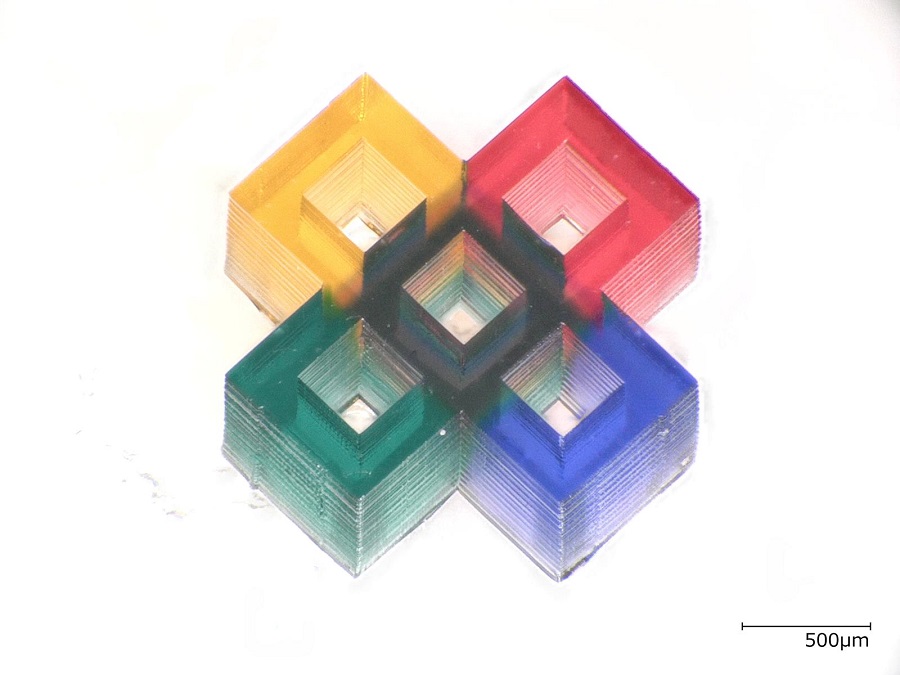About
16 September 2020
Researchers 3D Print Tiny Multicolor Microstructures
Automatic approach could enable precision fabrication of optical components and multimaterial structures
WASHINGTON — Researchers have developed an automated 3D printing method that can produce multicolor 3D microstructures using different materials. The new method could be used to make a variety of optical components including optical sensors and light-driven actuators as well as multimaterial structures for applications such as soft robotics and medical applications.

Caption: By adjusting the number of layers of multicolor resins, the researchers could adjust the light absorbance for each part of a structure. This allowed them to create black in microstructures such as this cross shape by combining layers of red, blue, green and yellow.
Credit: Shoji Maruo, Yokohama National University
“Combining multiple kinds of materials can be used to create a function that cannot be realized with a single material,” said research team leader Shoji Maruo from Yokohama National University in Japan. “Methods like ours that allow single-step fabrication of multimaterial structures eliminates assembling processes, allowing the production of devices with high precision and low cost.”
In The Optical Society (OSA) journal Optical Materials Express, Maruo and colleagues describe their new 3D printing method and demonstrate it by creating various multicolor 3D structures. Their technique is based on stereolithography, a 3D printing method that is ideal for making microdevices because it uses a tightly focused laser beam to make intricately detailed features.
“The ability to make multimaterial microscale optical elements using 3D printing could aid in the miniaturization of optical devices used for medical treatments and diagnoses,” said Maruo. “This could improve the ability to use these devices in or on the body while also enabling them to be disposable, which would help provide an advanced and safe medical diagnosis.”
Optimizing color stereolithography
Stereolithography builds up a high-precision 3D structure by using a laser to harden light-activated materials known as photocurable resins in a layer by layer fashion. Microfluidics are often used to hold the liquid resins, but it is challenging to keep the different resins from contaminating each other when switching materials without creating large amounts of waste or forming air bubbles in the printed object.
In the new work, the researchers developed a way to hold the various materials in a droplet state, which allows them to be more easily exchanged in a closed space such as a microchannel without creating waste. To suppress air bubbles, the 3D-printed structure is moved around inside the resin each time a resin is replaced. They also integrated a two-step process for cleaning the 3D printed structure when the resins are changed to completely prevent cross-contamination.

Caption: The researchers created a palette to hold multiple resins and placed it, two cleaning tanks and an air blow nozzle on a motorized stage. This allowed all the processes to be carried out sequentially for automated production of multicolor 3D microstructures.
Credit: Shoji Maruo, Yokohama National University
To implement this optimized approach, the researchers created a palette to hold multiple resins and placed it, two cleaning tanks and an air blow nozzle on a motorized stage. “All the processes, including 3D printing, resin replacement, bubble removal and cleaning are sequentially carried out using software we developed,” said Maruo. “This allows multicolor 3D microstructures to be created automatically.”
Creating multicolor 3D structures
The researchers tested the approach by placing various types of photocurable resins in a palette and using them to create 3D microstructures. For one of these demonstration structures, a tiny multicolor cube just 1.5 millimeters across, the 3D printing system exchanged five colors of resin 250 times during a 6-hour fabrication process. The researchers also showed that adjusting the number of layers of multicolor resins made it possible to adjust absorbance of each part of the structure, allowing them to create microstructures with colors such as black by combining layers of red, blue, green and yellow.
“This method can be applied not only to multicolor resins but also to a wider variety of materials,” said Maruo. “For example, mixing various ceramic micro- or nanoparticles with a photocurable resin can be used to 3D print various types of glass. It could also be used with biocompatible ceramic materials to create scaffolds for regenerating bones and teeth.”
The researchers are now working to shorten the time required for processes such as resin replacement and bubble removal to allow for even faster fabrication. They also plan to use technology they previously demonstrated to build a multiscale fabrication system in which the fabrication resolution can be changed from less than a micrometer to several tens of micrometers by modifying the focusing lens and laser exposure conditions.
Paper: T. Maruyama, H. Hirata, T. Furukawa, S. Maruo, “Multi-material microstereolithography using a palette with multicolor photocurable resins,” Opt. Mater. Express 10, 10, 2522-2532 (2020).
DOI: https://doi.org/10.1364/OME.401810.
About The Optical Society
The Optical Society (OSA) is dedicated to promoting the generation, application, archiving, and dissemination of knowledge in optics and photonics worldwide. Founded in 1916, it is the leading organization for scientists, engineers, business professionals, students, and others interested in the science of light. OSA’s renowned publications, meetings, online resources, and in-person activities fuel discoveries, shape real-life applications and accelerate scientific, technical, and educational achievement.
About Optical Materials Express
Optical Materials Express is an open-access journal focusing on the synthesis, processing and characterization of materials for applications in optics and photonics. It is published by Optica Publishing Group and emphasizes advances in novel optical materials, their properties, modeling, synthesis and fabrication techniques; how such materials contribute to novel optical behavior; and how they enable new or improved optical devices. The Editor-in-Chief is Andrea Alù from City University of New York, USA. For more information, visit Optical Materials Express.
Media Contact
